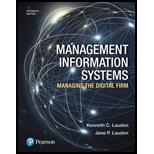
Explanation of Solution
Knowledge management:
- Knowledge management can be defined as the efficient handling of available information by organisations through a system of methods and procedures.
- The activities include creation, storage, distribution, or transfer of knowledge which are then utilised and applied to create awareness throughout the organisation.
Value of knowledge management to business:
The values provided to an organisation through knowledge management is mentioned below:
- It provides people in the organisation to utilise the knowledge and reapply it for gaining a competitive advantage.
- Efficient knowledge management can improve the revenues and profitability of the business.
Explanation of Solution
Important dimensions of knowledge:
The important dimensions of knowledge are as follows:
- Knowledge is a firm asset. It is an intangible asset and requires organisational resources to transform data into knowledge. It does not diminish over time, but instead increases as more people share it.
- Knowledge has different forms. It involves knowing procedures, certain craft, skills, where the information is codified or not, the time of happening, and so on.
- Knowledge has a location. It is a cognitive map of mental modes of individuals. It is embedded in the firm’s culture and works in certain situations only. It depends on the social and individual factors.
- Knowledge is situational. There is importance to know when the acquired knowledge is to be applied. So, it is a tool which needs to be applied to proper situations only.
Explanation of Solution
Difference between data, knowledge, and wisdom:
Data, Knowledge and Wisdom can be differentiated as follows:
- Data refers to raw and unstructured facts that needs to be processed to obtain useful information.
- Knowledge is the information that is processed and converted to identify patterns, rules.
Algorithms are used to convert that information into knowledge. - Wisdom is the utilisation of knowledge gained and applying them to solve a problem. It identifies how, where and when the knowledge needs to be used.
Difference between tacit knowledge and explicit knowledge:
The difference between tacit knowledge and explicit knowledge is shown below:
| Tacit knowledge | Explicit knowledge |
| It is Undocumented knowledge. | It is documented knowledge. |
| Difficult to represent in words or pictures. | Easy to represent in words and pictures. |
| Not possible for transfer between people. | Possible to transfer from person to person. |
| It is objective. | It is subjective. |
Explanation of Solution
Stages in knowledge management value chain:
The stages of knowledge management in value chain are mentioned below:
- Data and Information acquisition
- Knowledge acquiring
- Knowledge storage
- Knowledge dissemination
- Application of knowledge
Data and Information Acquisition:
It can be defined as the process of collecting data and processing them to convert into useful information.
Knowledge Acquiring:
- It is the process of gaining knowledge from an individual who is considered an expert to solve the problem.
- There are several ways to acquire knowledge.
- Patterns, rules, and algorithms are used to convert the information into knowledge.
- Examples include data mining, neural networks, and so on.
Knowledge Storage:
- It includes storage of documents, usage of patterns and rules to convert information to knowledge.
- The stored knowledge placed in a
database , can be retrieved by employees when required. - Expert systems and knowledge databases are examples of the same.
Knowledge Dissemination:
- To focus the attention of employees in a sea of available knowledge, dissection is done through collaboration of training programs, tools such as e-mail, social sites, presentations, and search engines.
- These documents help personnel in decision making and solving problems.
Knowledge Application:
- The application of knowledge acquired to solve problems and add business value to the organisation.
- Thereby providing a return on investment.
- Documents related to the knowledge are utilised in decision making processes.
- Example, Decision support systems.
Want to see more full solutions like this?
Chapter 11 Solutions
Management Information Systems: Managing the Digital Firm (15th Edition)
 Database System ConceptsComputer ScienceISBN:9780078022159Author:Abraham Silberschatz Professor, Henry F. Korth, S. SudarshanPublisher:McGraw-Hill Education
Database System ConceptsComputer ScienceISBN:9780078022159Author:Abraham Silberschatz Professor, Henry F. Korth, S. SudarshanPublisher:McGraw-Hill Education Starting Out with Python (4th Edition)Computer ScienceISBN:9780134444321Author:Tony GaddisPublisher:PEARSON
Starting Out with Python (4th Edition)Computer ScienceISBN:9780134444321Author:Tony GaddisPublisher:PEARSON Digital Fundamentals (11th Edition)Computer ScienceISBN:9780132737968Author:Thomas L. FloydPublisher:PEARSON
Digital Fundamentals (11th Edition)Computer ScienceISBN:9780132737968Author:Thomas L. FloydPublisher:PEARSON C How to Program (8th Edition)Computer ScienceISBN:9780133976892Author:Paul J. Deitel, Harvey DeitelPublisher:PEARSON
C How to Program (8th Edition)Computer ScienceISBN:9780133976892Author:Paul J. Deitel, Harvey DeitelPublisher:PEARSON Database Systems: Design, Implementation, & Manag...Computer ScienceISBN:9781337627900Author:Carlos Coronel, Steven MorrisPublisher:Cengage Learning
Database Systems: Design, Implementation, & Manag...Computer ScienceISBN:9781337627900Author:Carlos Coronel, Steven MorrisPublisher:Cengage Learning Programmable Logic ControllersComputer ScienceISBN:9780073373843Author:Frank D. PetruzellaPublisher:McGraw-Hill Education
Programmable Logic ControllersComputer ScienceISBN:9780073373843Author:Frank D. PetruzellaPublisher:McGraw-Hill Education





